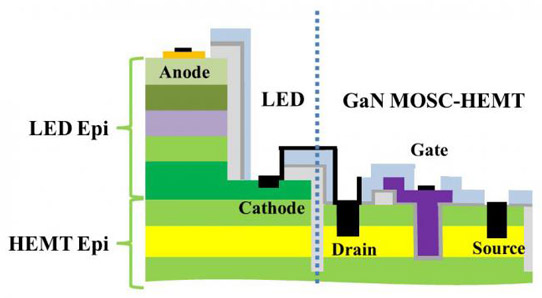The Smart Lighting Engineering Research Center at Rensselaer Polytechnic Institute (RPI) has demonstrated the first monolithic integration of LED and high electron mobility transistor (HEMT) on the same gallium nitride (GaN) chip. It is estimated that this pioneering work could facilitate the generation of new LED technology that is low-cost, more efficient, and which enables new functions beyond illumination.
In existing LED lighting systems, the external components including inductors, capacitors, silicon interconnects and wires, must be installed on or integrated into the chip. Due to these elementary components, the complex LED lighting systems slow the speed of assembly, and increase the labor and cost.
Led by T. Paul Chow, a professor in the Department of Electrical, Computer, and Systems Engineering at RPI, the researchers attempted to develop a chip with components all made from GaN. The monolithically integration simplifies LED device manufacturing, requiring fewer assembly steps and less automation. Also, it is reckoned that LED devices made with monolithically integrated chips will have less parts malfunction, higher energy efficiency and cost effectiveness, and greater lighting design flexibility.
The research team directly interconnects a GaN LED structure and a GaN HEMT structure to create the first monolithic integration of a HEMT and an LED on the same GaN-based chip. The device, grown on a sapphire substrate, demonstrated light output and light density comparable to standard GaN LED devices. Professor Chow regards this study as a key step toward creating a new class of optoelectronic device: the light-emitting integrated circuit (LEIC).
Just as the integration of many silicon devices in a single chip(such as integrated circuits) has enabled powerful compact computers and a wide range of smart device technology, the LEIC will play an important role in cost-effective monolithic integration of electronics and LED technology for new smart lighting applications and more efficient LED lighting systems. LEICs will result in even higher energy efficiency of LED lighting systems. The new devices, new applications, and new breakthroughs enabled by LEICs will truly usher the smart lighting era.













